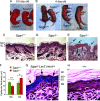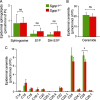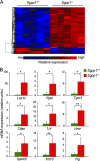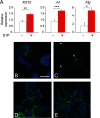Sphingosine-1-phosphate phosphatase 1 regulates keratinocyte differentiation and epidermal homeostasis
- PMID: 23637227
- PMCID: PMC3689979
- DOI: 10.1074/jbc.M113.478420
Sphingosine-1-phosphate phosphatase 1 regulates keratinocyte differentiation and epidermal homeostasis
Abstract
Sphingosine 1-phosphate (S1P) is a bioactive lipid whose levels are tightly regulated by its synthesis and degradation. Intracellularly, S1P is dephosphorylated by the actions of two S1P-specific phosphatases, sphingosine-1-phosphate phosphatases 1 and 2. To identify the physiological functions of S1P phosphatase 1, we have studied mice with its gene, Sgpp1, deleted. Sgpp1(-/-) mice appeared normal at birth, but during the 1st week of life they exhibited stunted growth and suffered desquamation, with most dying before weaning. Both Sgpp1(-/-) pups and surviving adults exhibited multiple epidermal abnormalities. Interestingly, the epidermal permeability barrier developed normally during embryogenesis in Sgpp1(-/-) mice. Keratinocytes isolated from the skin of Sgpp1(-/-) pups had increased intracellular S1P levels and displayed a gene expression profile that indicated overexpression of genes associated with keratinocyte differentiation. The results reveal S1P metabolism as a regulator of keratinocyte differentiation and epidermal homeostasis.
Keywords: Epidermis; Keratinocytes; Metabolism; Sgpp1; Sphingolipid; Sphingosine-1-phosphate.
Figures










Similar articles
-
Sphingosine-1-phosphate Phosphatase 2 Regulates Pancreatic Islet β-Cell Endoplasmic Reticulum Stress and Proliferation.J Biol Chem. 2016 Jun 3;291(23):12029-38. doi: 10.1074/jbc.M116.728170. Epub 2016 Apr 8. J Biol Chem. 2016. PMID: 27059959 Free PMC article.
-
K6PC-5, a direct activator of sphingosine kinase 1, promotes epidermal differentiation through intracellular Ca2+ signaling.J Invest Dermatol. 2008 Sep;128(9):2166-78. doi: 10.1038/jid.2008.66. Epub 2008 Apr 3. J Invest Dermatol. 2008. PMID: 18385762
-
Role of human sphingosine-1-phosphate phosphatase 1 in the regulation of intra- and extracellular sphingosine-1-phosphate levels and cell viability.J Biol Chem. 2003 Sep 5;278(36):34541-7. doi: 10.1074/jbc.M301741200. Epub 2003 Jun 18. J Biol Chem. 2003. PMID: 12815058
-
Translational aspects of sphingosine 1-phosphate biology.Trends Mol Med. 2011 Aug;17(8):463-72. doi: 10.1016/j.molmed.2011.03.002. Epub 2011 Apr 21. Trends Mol Med. 2011. PMID: 21514226 Review.
-
Regulation of metabolism and transport of sphingosine-1-phosphate in mammalian cells.Mol Cell Biochem. 2012 Apr;363(1-2):21-33. doi: 10.1007/s11010-011-1154-1. Epub 2011 Nov 24. Mol Cell Biochem. 2012. PMID: 22113622 Review.
Cited by
-
Inhibition of sphingosine 1-phosphate lyase activates human keratinocyte differentiation and attenuates psoriasis in mice.J Lipid Res. 2020 Jan;61(1):20-32. doi: 10.1194/jlr.RA119000254. Epub 2019 Nov 5. J Lipid Res. 2020. PMID: 31690639 Free PMC article.
-
Sphingosine-1-phosphate phosphatase 2 promotes disruption of mucosal integrity, and contributes to ulcerative colitis in mice and humans.FASEB J. 2016 Aug;30(8):2945-58. doi: 10.1096/fj.201600394R. Epub 2016 Apr 29. FASEB J. 2016. PMID: 27130484 Free PMC article.
-
Nuclear Translocation of SGPP-1 and Decrease of SGPL-1 Activity Contribute to Sphingolipid Rheostat Regulation of Inflammatory Dendritic Cells.Mediators Inflamm. 2017;2017:5187368. doi: 10.1155/2017/5187368. Epub 2017 Dec 11. Mediators Inflamm. 2017. PMID: 29375197 Free PMC article.
-
Runx1 Orchestrates Sphingolipid Metabolism and Glucocorticoid Resistance in Lymphomagenesis.J Cell Biochem. 2017 Jun;118(6):1432-1441. doi: 10.1002/jcb.25802. Epub 2017 Jan 10. J Cell Biochem. 2017. PMID: 27869314 Free PMC article.
-
Sphingolipid metabolism and regulated cell death in malignant melanoma.Apoptosis. 2024 Dec;29(11-12):1860-1878. doi: 10.1007/s10495-024-02002-y. Epub 2024 Jul 28. Apoptosis. 2024. PMID: 39068623 Review.
References
Publication types
MeSH terms
Substances
Grants and funding
LinkOut - more resources
Full Text Sources
Other Literature Sources
Molecular Biology Databases

